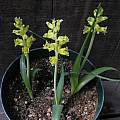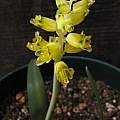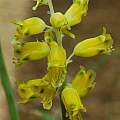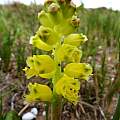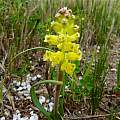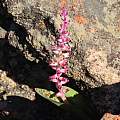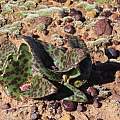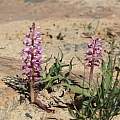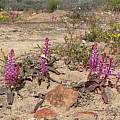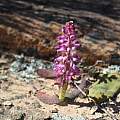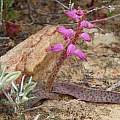Lachenalia is a genus with bulbs in the Hyacinthaceae family found in Namibia and South Africa. The first complete illustrated systematic monograph of this genus by Graham Duncan The Genus Lachenalia was published in 2012. There are around 110 species (80 of those are found in the Cape region.) Most of these have a dormancy period and grow new roots each year. Lachenalia species j-n are found on this page.
Lachenalia a - Lachenalia b-c - Lachenalia Species d-i - Lachenalia o-p - Lachenalia q-t - Lachenalia u-z - Polyxena - Lachenalia index
Lachenalia juncifolia Baker is found in sand or limestone outcrops in the winter rainfall Cape. It has two leaves with maroon bands and white or pink bell shaped flowers on long pedicels with exserted anthers. Height range: 7-40 cm. Don Journet describes it in his collection. "The flowers consist of outer perianth segments which have a blush tinge at their base grading to pink and finally a rose-purple tip and gibbosities. The inner segments, which are largely hidden, have the same dark rose-purple tips showing between the outer segments. The flowering season has been fairly short for me being the third week in September to the second week in October." The first photo from Rod Saunders. The rest from Mary Sue Ittner.
Lachenalia juncifolia var. campanulata W. F. Barker is a synonym of Lachenalia magentea.
Lachenalia karooica W.F.Barker ex G.D. Duncan is native to rocky outcrops and loamy to clayey soils in the Northwest Cape (Worcester district and Great Karoo to western Free State.) Plants are small from 4 to 22 cm high with 1 to 2 lanceolate leaves that lie on the ground and often have dark spots on the upper surface. Flowers have no stalks, and are bell shaped and light green to turquoise green with maroon or brown markings. Anthers are exserted. Plants are winter growing and winter to spring flowering (June to September). Photo from the book Plants of the Klein Karoo courtesy of Jan and Anne Lise Schutte-Vlok.
Lachenalia karoopoortensis G.D.Duncan, syn. Lachenalia elegans var. flava W.F. Barker, was named by Graham Duncan in 2012 when he elevated the Lachenalia elegans variety to species level. There was already a species with the name Lachenalia flava so he selected a new name. This is a small species growing from 13 to 25 cm high and flowering early July to mid August. It is restricted to the Southwestern Cape. It usually has one leaf (rarely two) with dark green blotches on its upper surface and a maroon crisped margin. Flowers are without pedicels and bright yellow with shorter inner tepals and maroon markings with bright white margins. Stamens are included. Photo by Rod Saunders
Lachenalia kliprandensis W.F. Barker is from Kliprand (southwestern Bushland) South Africa where it grows in red sand, has two ovate prostrate leaves with dark brown or green pustules on the surface and white flowers with brownish green gibbosities and pale magenta tips. Inner segments are white with broad magenta tips. This species resembles Lachenalia carnosa. Height range: 10-20 cm. The first photo is from Alan Horstmann. The second photo is from Rod Saunders. The last two photos by Mary Sue Ittner show plants grown from Silverhill Seeds.
Lachenalia latimerae W.F.Barker is uncommon in its distribution from the Little Karoo (Oudtshoorn to the Kouga Mountains) to the Eastern Cape where it grows mostly in the shade of shrubs. Plants are winter growing from 15 to 30 cm high with 1 to 2 narrow erect leaves with clear purple spots on the lower leaf surface. Flowers are stalked, mauve-grey to pale pink, bell-shaped with greenish brown markings. This species flowers late winter to early spring (July to September). The first photo from the book Plants of the Klein Karoo courtesy of Jan and Anne Lise Schutte-Vlok. The second photo was taken by Alan Horstmann. Other photos from Bert Zaalberg.
Lachenalia leipoldtii G.D.Duncan grows on sandstone slopes in the Western Cape from the Olifants River valley to the Karoo. Growing to 28 cm, it has one to two lanceolate leaves, sometimes spotted, a light green scape spotted with maroon blotches, and a many flowered raceme of bell-shaped cream to greenish yellow flowers with well exserted anthers. It flowers August to September. Photos from Bert Zaalberg.
Lachenalia liliflora Jacq. is from hilly slopes in the renosterveld in the southwestern Cape and blooms in spring. The bell-shaped flowers have short pedicels and are white with brownish markings and magenta tips. It is one of the later flowering species. Height: 10-20 cm. Photo 1 was taken by Alan Horstmann, photos 2-3 by Mary Sue Ittner, and photos 4-5 by Nhu Nguyen.
Lachenalia longibracteata Phillips is found on clay flats and slopes in the northwest and southwest Cape. It has shortly pedicellate or sessile flowers that are bell-shaped. Each flower has a long bract at the base. The flowers are pale blue or yellow with a blue base and brown or green markings. Height range: 7-35 cm tall. Flowering in the wild is from July to September. The anthers are included. Photos by Alan Horstmann and Rod Saunders
Lachenalia lutea G.D. Duncan, a species named in 2006, grows in heavy clay soil in renosterveld in the southwestern cape and has greenish yellow oblong-campanulate sweetly scented flowers without pedicels and with anthers included. Growing from 16 to 24 cm high, it flowers July to October. Photo by Colin Davis.
Lachenalia luteola Jacq., syn. Lachenalia tricolor Thunb . var luteola (Jacq.) Baker, is one of the seven species that until 2012 were thought to belong to Lachenalia aloides. It is distributed in the Southern Cape peninsula and flowers August to November. Growing from 15 to 34 cm high, it is a variable species. The typical forms have greenish-yellow, yellowish-green or mustard outer and inner tepals with green markings; the top of the flowering stalk is bright reddish-orange or mustard yellow. Inner tepals are 14 to 20 mm long. Other forms have outer tepals that are bright reddish-orange at the base, shading to bright yellow with green markings and inner tepals that are bright yellow or greenish yellow with magenta markings. Photos from iNaturalist taken by Paul Coulthard in September on the Cape Peninsula and shared under a CC BY-NC license and Tony Rebelo in Table Mountain National Park in September and shared under a CC BY-SA license.
Some of the distinctions in morphology between the seven species are very subtle and because the flowers change color in different stages and the ones in cultivation may have hybridized deciding which photograph uploaded before the splint belongs to which species is a challenge. This is especially true since you can not measure sizes from photos. The first photo from Colin Davis was received as Lachenalia tricolor but could also be Lachenalia callista. The second photo from Nhu Nguyen was thought to be Lachenalia quadricolor but fits the description of one of the forms of this species as well.
Lachenalia lutzeyeri G.D. Duncan is mostly known from the Grootbos Private Nature Reserve where it grows in full sun between sandstone boulders. Height: 20-40 cm. There it flowers from November to December. It is dependent on summer or autumn fires to flower. It has oblong-campanulate pink flowers with exserted stamens. Photos from iNaturalist taken by Vera Frith in October in the Overberg where it was growing on a limestone outcrop and flowering the first spring after a fire. Photos shared under a CC BY-NC license.
Lachenalia magentea G.D. Duncan, syn. Lachenalia juncifolia var. campanulata W. F. Barker, was elevated to species status in 2012. It is confined to the southern Cape coastal belt where it grows in colonies in shallow seasonally moist sand. It differs from Lachenlia juncifolia in its smaller, oblong-campanulate flowers and in its grooved channeled lengthwise less fleshy leaves. It flowers August to October. Don Journet described it in his collection as flowering for a relatively short period in late September and early October. Also: "It has open bell-shaped flowers that although rather small, are nevertheless very attractive. The flowers are almost white with the main colour being in the rose purple gibbosities and keel on the inner perianth segments. The bulbs are generally very small, only a few millimetres in diameter, and are easily overlooked when sorting through the potting mix at the end of the season. The leaves are semi-terete and can be mistaken for grass by the less experienced collector. Height range: 30-45 cm. The photos below from iNaturalist were taken by Charleen Brunke and Mike Brunke September 2022 and shared under a CC BY-NC license.
Lachenalia marginata W.F.Barker grows in fynbos in acidic sand or gravel on flats and lower to medium slopes in the northwestern Cape (Bokkeveld Plateau to Clanwilliam). Growing from 11 to 30 cm high, it has one ovate or lanceolate clasping leaf, marked brown or green, and sweetly scented greenish-yellow flowers with dark brown markings. Flowers are sessile with stamens included. It flowers June to September. Photos from Alan Horstmann. The first photo was taken in the Cederberg Mountains. The next two photos were taken south of Vanrhynsdorp.
Lachenalia mathewsii W.F. Barker is found only on the South African Cape west coast on moist lower slopes. It flowers in spring (September) and is yellow with green markings. Plants grow from 10 to 20 cm, and flowers are shortly pedicellate with anthers exserted. The first four photos of cultivated plants were taken by Mary Sue Ittner. The last two photos in habitat were taken by Cameron McMaster September 2011.
Lachenalia mediana Jacq. grows in seasonally wet to moist clay soil in the southwest Cape, flowering August to November. Flowers are pale blue and white or pinkish blue, with green or purple markings and bell-shaped with short pedicels. Stamens are included to shortly exserted. Height range: 20-40 cm. In Duncan's book he lists two subspecies, ssp. mediana and Lachenalia mediana ssp. rogersii (Baker) G.D.Duncan. Photos from Mary Sue Ittner.
Lachenalia membranacea (W.F.Barker) G.D.Duncan was elevated to species level from Lachenalia elegans var. membranacea W.F.Barker by Graham Duncan in 2012. It has a many flowered dense spicate inflorescence with a light green to pinkish maroon scape and 1 to 2 lanceolate spotted leaves. The flower buds are pink and the outer tepals are pale or dark yellow to green with green and brown markings and a white membranous margin. Stamens are included. Growing from 11 to 25 cm, it flowers from July to September. The first four photos were taken by Alan Horstmann. They don't quite match the description from Duncan's book, but Lachenalia flowers change colors over time. The last photo was taken by Nhu Nguyen at the UC Botanical Garden.
Lachenalia minima W.F.Barker is a northwestern Cape dwarf species that grows on seasonally moist flats in heavy clay that bakes hard in summer. Growing from 2 to 10 cm high, it has two lanceolate spreading dark green leaves and greenish yellow flowers aging to dull red. Stamens are included. Flowering is in June. Photos from Alan Horstmann.
Lachenalia multifolia W.F. Barker is found on rocky slopes in crevices in the Tanqua Karoo and the Roggeveld. It has many grasslike leaves and pedicellate, cream colored widely bell-shaped scented flowers with exserted anthers. The tips of the tepals are light green and brown. It resembles Lachenalia liliflora and sister species Lachenalia orthopetala. It flowers September to October. Height range: 7-20 cm. It takes 4 years to bloom this species from seeds. Photos taken by Nhu Nguyen.
Lachenalia mutabilis Sweet is found on sandy and stony slopes in the north and southwestern Cape and Namaqualand. There are many forms of this species. Growing from 10 to 45 cm high, this species has a single lanceolate erect leaf with crisped margins. Flowers are narrowly urn-shaped, blue with yellow tips or yellowish green with brown markings. Flowering is from July to September. It is distinguished by having a number of sterile flowers on the apex. Photo 1 taken by Mary Sue Ittner, shows plants growing in the wild between Clanwilliam and Citrusdal. Photo 2 was taken by Cameron McMaster in the Overberg.
The photos below are of plants in cultivation. Photo 1 by Bob Rutemoeller shows a form grown from seed by Mary Sue Ittner. Photos 2-3 show the same form as photo 1 grown by Nhu Nguyen. Photo 4 shows plants grown in California by Michael Mace. Photo 5 by Bob Rutemoeller is of a dwarf form that was grown by Alan Horstmann in South Africa.
Lachenalia namaquensis W.F. Barker is found in Namaqualand in exposed rocky habitats and has urn-shaped striking magenta flowers which are quite eye catching. The outer perianth segments have a tinge of blue at the base but then shade through a pink magenta to a deep magenta at the tips. The gibbosities are magenta and green. The magenta inner segments protrude beyond the outer segments and flare out adding to the colour mass. Description by Don Journet. Height range: 10-40 cm. The first photo was taken by Bob Rutemoeller. The second was taken by Andrew Harvie northwest of Steinkopf in Namaqualand. The last photo is from Bert Zaalberg.
Lachenalia namibiensis W.F. Barker is an attractive dwarf species from southwestern Namibia with white bell-shaped flowers with pink markings. It flowers in August. Photo by Alan Horstmann.
Lachenalia nardousbergensis G.D.Duncan has a limited distribution in fynbos in the Western Cape from Nieuwoudtville to the northern Cederberg, with one more outlier in northern Piketberg. It has two prostrate olive green pustulated leaves and campanulate magenta flowers with exserted stamens and grows to about 30 cm tall. It flowers late August to early October. The first photo was taken by Margaret Fox. The next four photos were taken by Alan Horstmann.
The photos below were taken by Richard Sullivan and show a plant in cultivation.
Lachenalia neilii W.F.Barker ex G.D.Duncan is found on dolerite flats in the Bokkeveld Plateau east of Nieuwoudtville. Considered endangered, it has two lanceolate leaves, sometimes speckled with maroon, and narrow bell-shaped greenish white flowers. Height range: 12-32 cm. It flowers August to October. Photo from Bert Zaalberg.
Lachenalia nervosa Ker Gawl. (syn. Lachenalia latifolia Tratt.) grows on coastal grassland in the southern Cape and has two leaves that are sometimes pustulate with longitudinal veins and bell-shaped white flowers with reddish pink markings and exserted anthers, growing 15-30 cm high. The first two photos from Bob Rutemoeller are of flowers and leaves. The last two were taken by Cameron McMaster in Napier in the Overberg.
Lachenalia a - Lachenalia b-c - Lachenalia Species d-i - Lachenalia o-p - Lachenalia q-t - Lachenalia u-z - Polyxena - Lachenalia index











































